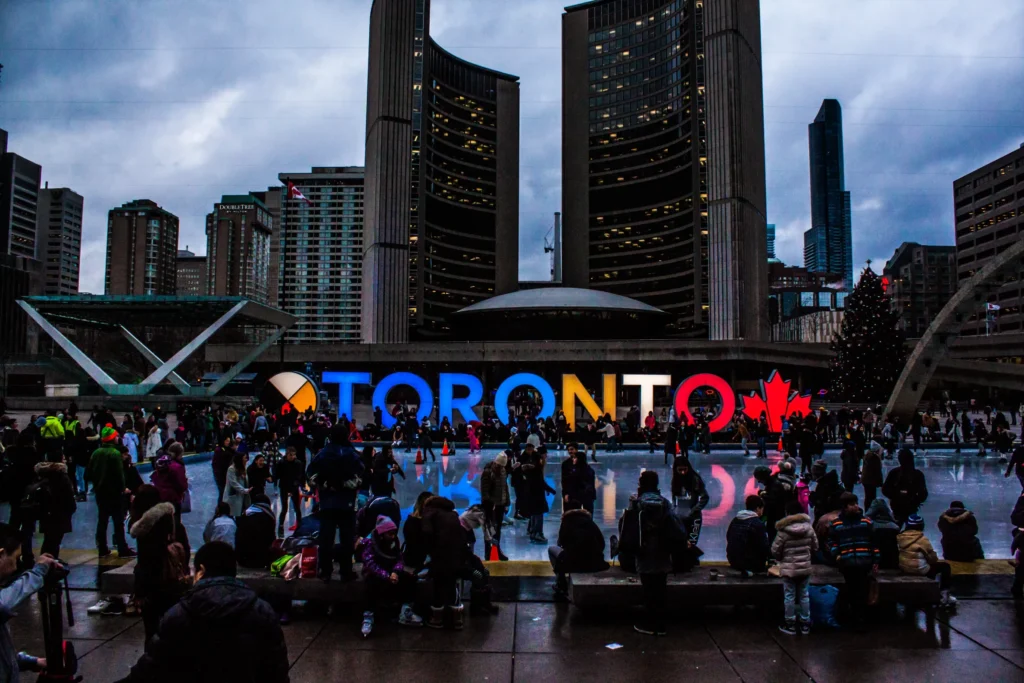Canada is one of my favorite countries to visit and immigrate to. The friendly people, beautiful landscapes, and world-class cities make it a top destination for travelers and immigrants alike. However, many people think the only way to spend an extended time in Canada is to study or work there. That’s not true! There are actually a number of other ways to travel to Canada, even if you don’t have a job or study offer.
In this blog post, I’ll share two great options for traveling to Canada: Express Entry and visitor visas. I’ll explain what each visa is, who is eligible for them, and how to apply for them.
Before diving into the details of Express Entry and visitor visas, think about your own goals and timeline for wanting to go to Canada. Making this decision first will help determine which option below is best for you.
Here are some key questions to ask yourself:
- Do you want to immigrate and settle in Canada permanently someday, or are you only looking to visit temporarily for now?
- What length of stay are you hoping for – a few weeks/months as a tourist, or permanent resident status?
- What ties do you have to your current home country? Strong ties make a visitor visa more suitable.
- How quickly do you need to make the trip? Express Entry application processing takes 6+ months, visitor visas can be faster.
- Do you have skilled work experience that would qualify you for Express Entry immigration? This program is for economic immigrants.
- What activities do you want to do during your time in Canada? Working and studying require different permits than just travelling/tourism.
Think about your own situation and goals and how they align with the Express Entry permanent residency programme versus a temporary visitor visa. This will help determine which direction is right for you!
Now, let’s explore the two options in more detail:


Immigrate through Express Entry.
Express Entry is a points-based system that allows skilled workers to immigrate to Canada. To be eligible for Express Entry, you must have a certain level of education, work experience, and language proficiency. You will also need to create an online profile and score enough points to be invited to apply for permanent residence.
I have a friend who successfully immigrated to Canada through Express Entry. She had worked for several years as a software developer in Europe before deciding she wanted to move overseas. Here’s a bit about her experience and what the process involves:
There are three main programmes you can apply through:
- Canadian Experience Class: This is for skilled workers who have recent work experience in Canada. My friend didn’t qualify for this since she had never worked in Canada before.
- Federal Skilled Worker Program: This programme is for those with foreign work experience that can transfer well to the Canadian job market. Since my friend had years of experience as a developer, this ended up being the programme she applied to.
- Federal Skilled Trades Program: For workers with experience in eligible skilled trades like construction. Not applicable to my friend’s office-based tech work.
Once you determine which programme fits you best, the process involves several key steps:
- Confirm you’re eligible based on work experience, education, language ability and other factors. My friend spent time gathering all her employment records, educational credentials, and English language test scores to prove her eligibility.
- Calculate your ranking score using Canada’s Comprehensive Ranking System. This awards points for skills, education, languages, work experience and other attributes. My friend scored quite high thanks to her tech background and English fluency.
- Submit your online Express Entry profile. This is where you provide all your documentation on education, work history, languages, etc. My friend said gathering all the paperwork took some time, but it was worth it in the end.
- Get placed in the pool of candidates and hope to get an invitation to apply! Express Entry ranks all candidates based on those Comprehensive Ranking System points. The highest scoring applicants get invited to formally apply for permanent residence. Luckily, my friend scored high enough to get her invitation within a few short months.
- Submit your complete application within 60 days. This involves forms, proof of funds, police certificates, medical checks and more. My friend worked diligently to get all her documents in.
- Wait for approval! If all goes well, you’ll get approved for permanent residence within 6 months or less. My friend now lives happily in Toronto, working for a great tech firm.


Provincial Nominee Program (PNP)
The Provincial Nominee Program (PNP) is a way for skilled workers to immigrate to Canada through a province or territory. Each province and territory has its own set of criteria, so you’ll need to research the specific programmes that are available. Check out their websites for eligibility and how to apply:
- Alberta
- British Columbia
- Manitoba
- New Brunswick
- Newfoundland and Labrador
- Northwest Territories
- Nova Scotia
- Ontario
- Prince Edward Island
- Saskatchewan
- Yukon
There are two ways to apply for the PNP: through the non-Express Entry process or through Express Entry.
Non-Express Entry process
In the non-Express Entry process, you’ll first need to apply to the province or territory for nomination. If you’re nominated, you’ll then be able to apply for permanent residence.
The non-Express Entry process typically takes longer than the Express Entry process. However, it may be a good option for you if you don’t meet the criteria for Express Entry or if you’re not comfortable with the online system.
Express Entry process
In the Express Entry process, you’ll create an Express Entry profile and indicate that you’re interested in a PNP. If a province or territory is interested in nominating you, they’ll send you a notification of interest. You can then apply to their PNP, and if you’re successful, you’ll be invited to apply for permanent residence.
The Express Entry process is typically faster than the non-Express Entry process. However, it’s more competitive, and you’ll need to have a high score in the Express Entry system to be invited to apply for permanent residence.
Which process is right for you?
The best way to decide which process is right for you is to research the specific programmes that are available and talk to an immigration lawyer or consultant. They can help you assess your eligibility and choose the process that’s most likely to be successful for you.
Here are some additional things to keep in mind when applying for the PNP:
- You’ll need to meet the eligibility criteria for the province or territory you’re applying to.
- You’ll need to have a valid job offer in the province or territory.
- You’ll need to pass a medical exam and get a police check.
- You’ll need to be able to support yourself financially in Canada.
The PNP is a great way to immigrate to Canada if you have the skills and experience that a province or territory is looking for. If you’re interested in applying, I recommend that you start your research today.
As you can see, Express Entry offers a clear path for skilled immigrants to gain permanent residency. While it takes dedication and patience, it’s an incredible way to immigrate to Canada for the long term without pursuing further studies or job offers.


Get a Visitor Visa
Visitor visas allow people to travel to Canada for tourism or business purposes. To be eligible for a visitor visa, you must have a valid passport, proof of financial support, and a return ticket.
Here are some important tips to set yourself up for success when applying for a Canadian visitor visa:
- Show ties to your home country – Provide proof like property ownership, employment, and family responsibilities that will ensure you return home after a temporary visit.
- Get appropriate travel medical insurance – Canada does not cover medical services for visitors, so insurance is essential in case you get sick or injured during your stay.
- Have a detailed itinerary – Booking hotels, flights, and listing planned activities shows you have a schedule as a tourist.
- Save up adequate funds – You’ll need to prove you have enough savings to cover costs in Canada. Move money into your account early to build up bank statements.
- Apply well in advance – We recommend applying at least 2-3 months before your planned trip, as visa processing varies. Don’t leave it to the last minute!
Alternatively, you may wish to simply visit Canada for up to 6 months as a tourist. I did this myself a few years back and had an amazing time exploring Banff, Vancouver, and other scenic spots.
Here’s a bit about getting a Canadian visitor visa:
First, you’ll need to check if you even require a visa based on your nationality. Citizens from certain countries, like the USA and most of Europe, do not need visas for short Canada trips. But I hold a passport from Nigeria, so unfortunately, I did need to get a visa.
The visitor visa application process involves:
- Preparing supporting documents: This includes travel history to show previous compliance with visas, bank statements to prove you can support yourself financially in Canada, travel bookings/itineraries, and more. I spent a lot of time gathering all the papers required.
- Applying online and paying the $100 CAD fee – I applied through Canada’s official website and paid via credit card. Pretty straightforward process.
- Providing biometrics if required: For folks like me from certain countries, I had to visit a Canadian visa application centre to provide fingerprints and get photographed. An extra step, but it didn’t take too long.
- Waiting for approval: It took about 2 months for my visa to get approved. I sent in my passport per their request to get the visa printed.
- Flying to Canada and showing my visa: When I landed in Vancouver, the border officer verified my visa and granted me 6 months of entry as a tourist. Success!
The Canadian Rockies were breathtaking. I spent 3 incredible months touring Banff and Jasper national parks, hiking through the mountains, seeing wildlife like bears and moose, and making great friends along the way. It was an unforgettable experience that my visitor visa made possible.


So in summary, a visitor visa is the way to go if you want to spend up to 6 months enjoying Canada as a tourist. Just be sure to allow time for the application processing—it’s well worth the wait!
No matter if you’re looking to immigrate permanently or just visit temporarily, Express Entry and visitor visas allow you to pursue extended Canadian travel without being a student or employee. Both options involve document gathering and processing times, but they’re absolutely doable if you’re patient and diligent. Apply for the one that fits your goals, and get ready for an amazing Canadian adventure!
For more information directly from the Government of Canada, check out these resources:
Visitor visa application guide
Frequently Asked Questions
Q: How long does it take to immigrate through Express Entry?
A: The entire process can take as little as 6 months if you have all your documentation ready. The application processing time is typically 2–6 months after you submit your complete application package.
Q: What are the basic eligibility requirements for Express Entry?
A: You must have work experience in an eligible skilled occupation, meet minimum language requirements, have completed post-secondary education, and meet other criteria. Check the Express Entry website for full details.
Q: How long can I stay in Canada with a visitor visa?
A: A visitor visa allows you to stay in Canada for up to 6 months at a time. The border officer can set a shorter or longer maximum stay when you first arrive.
Q: Can I work or study in Canada on a visitor visa?
A: No, a visitor visa does not allow you to work or pursue studies in Canada. It is for tourism, visiting family, or business trips only.
Q: How early should I apply for a visitor visa?
A: We recommend applying at least 2–3 months in advance if possible, as processing times can vary. Applying early ensures you get approved in time for your planned trip.
Q: How long is my visitor visa valid for?
A: A visitor visa is usually valid for 10 years, allowing you to make multiple trips to Canada within that time period, each up to 6 months.
Q: Can I apply for jobs in Canada while on a visitor visa?
A: You cannot work in Canada while on a visitor visa, but you can network and interview with potential employers to secure a job offer. Switching to a work permit is possible once you have a valid Canadian job offer.
Q: What is the cost to apply for Express Entry or a visitor visa?
A: To apply for Express Entry, there is a fee of $2,300 CAD for a single person and $4,500 CAD for a couple. On the other hand, a visitor visa application has a cost of $100 CAD. There may be additional biometric fees in certain cases.








